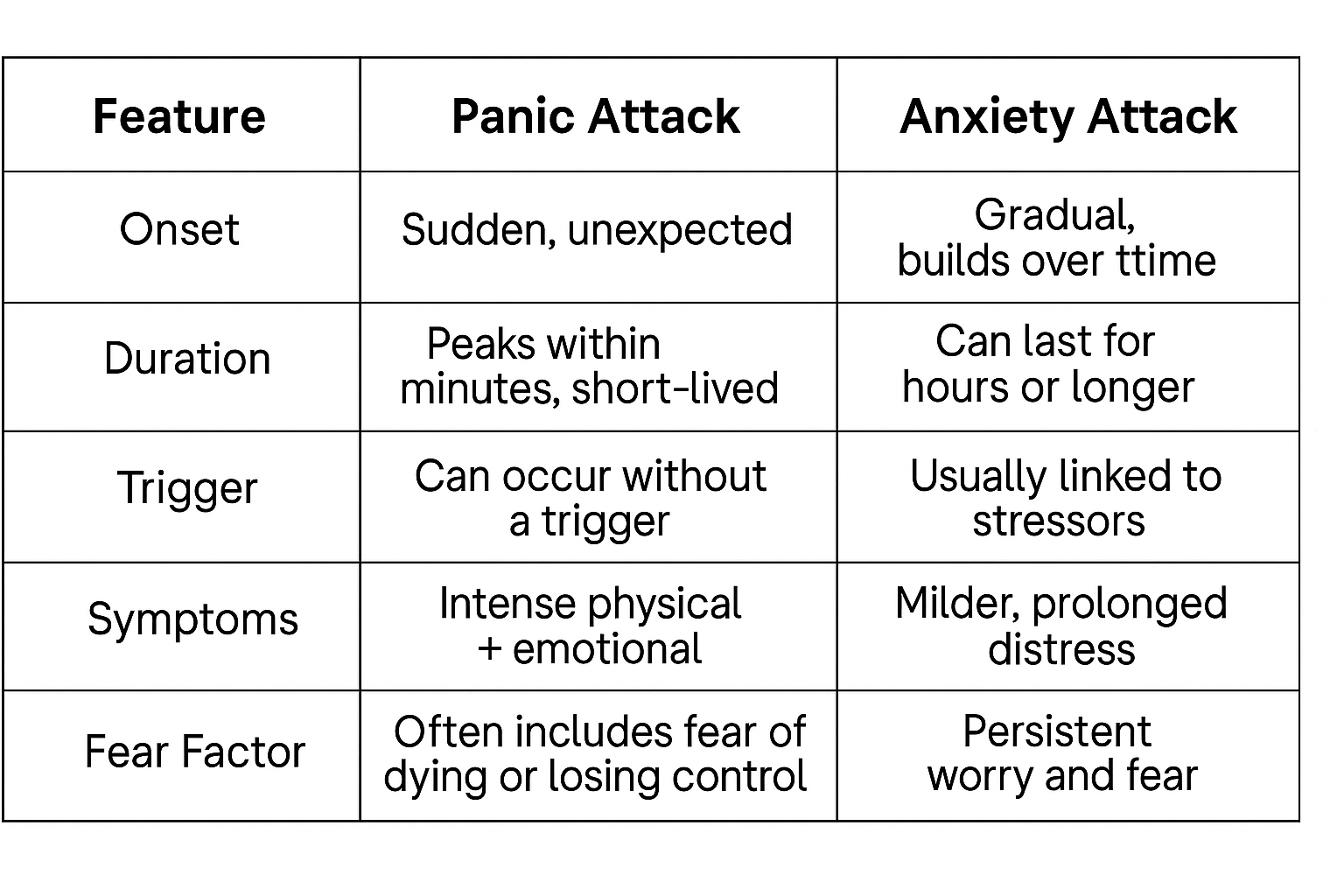Panic Attack vs. Anxiety Attack: Understanding the Differences
In today’s fast-paced world, overwhelming stress and anxiety are common. But when distress peaks, many people wonder: Am I having a panic attack or an anxiety attack?
Although these terms are often used interchangeably, they describe different experiences. Panic attacks come on suddenly and intensely, while anxiety attacks typically build gradually and last longer..Understanding the difference can help you recognize symptoms, respond effectively, and seek the right treatment.
What Is a Panic Attack? (Symptoms & Why They Happen)
A panic attack is an intense and sudden episode of extreme fear or discomfort that usually peaks within minutes. These attacks may happen unexpectedly or be triggered by a specific situation..
Common panic attack symptoms include:
Rapid heartbeat or palpitations
Shortness of breath or a feeling of being smothered
Chest pain or discomfort
Dizziness or lightheadedness
Trembling or shaking
Sweating
Nausea or stomach distress
Chills or hot flashes
Feelings of detachment from reality (derealization) or oneself (depersonalization)
Fear of losing control or dying
Panic attacks are frightening but short-lived. Many people fear their symptoms mean something is medically wrong, but the truth is, these attacks are not life-threatening. While the racing heart, chest pain, and dizziness can feel overwhelming, panic attacks are the body’s stress response — not a medical emergency.
What Is an Anxiety Attack? (Symptoms & Causes)
Unlike panic attacks, the term “anxiety attack” is not a clinical diagnosis in the DSM-5 (Diagnostic and Statistical Manual of Mental Disorders). Instead, it’s a commonly used term to describe a heightened period of anxiety. These episodes are often triggered and typically come about from the individual ruminating about whatever triggered them.
Common anxiety attack symptoms include:
Excessive worry or fear
Restlessness or feeling on edge
Increased heart rate
Muscle tension
Difficulty concentrating
Fatigue or trouble sleeping
Irritability
Shortness of breath (though usually milder than in panic attacks)
A sense of impending doom, though less intense than in a panic attack
Anxiety attacks usually occur due to prolonged stress or worry about specific situations, such as work pressure, relationships, or health concerns. They tend to be longer-lasting than panic attacks and can persist for hours or even days.
Panic Attack vs. Anxiety Attack: What’s the Difference?
Differentiation of panic attack symptoms vs anxiety attach symptoms
Are Panic Attacks and Anxiety Attacks the Same?
No. While both involve anxiety, they show up differently in the body and mind.
In my experience, panic attacks often point to a deeper struggle with emotion identification and expression. Many people who have panic attacks are unconsciously suppressing emotions. The body can only hold that stress in for so long, so it eventually comes out in a physical, uncontrollable way. This is why panic attacks feel so overwhelming and intense.
By contrast, anxiety attacks are usually tied to over-awareness and misinterpretation of normal body sensations. They tend to build gradually and are fueled by rumination — the mental loop of overthinking and worrying. That’s why I often focus on interoceptive work (learning to face and tolerate body sensations) and teaching clients how to stop spiraling into “what if” thinking.
Understanding these differences matters for treatment. Someone experiencing panic disorder may need support with emotional awareness and safe expression, while someone experiencing frequent anxiety attacks may benefit from ERP techniques, interoceptive exposure, and strategies to reduce rumination.
How to Cope With Panic and Anxiety Attacks
Both panic and anxiety attacks can be managed with the right strategies and professional support. Here are some of the most effective, evidence-based tools:
Introceptive Exposures: Panic attacks often come from an overawareness and misinterpretation of body sensations. With the help of a trained therapist, interoceptive exposures re-create these sensations in a safe setting. Over time, you’ll learn that racing heart, shortness of breath, or dizziness are not dangerous and you don’t need to fear them.
Response Prevention: During panic or anxiety attacks, it’s common to reach for “safety behaviors” like deep breathing, escaping, or avoiding situations. But these behaviors actually reinforce the fear. ERP teaches you to resist these safety responses, helping your brain relearn that you can handle discomfort without relying on quick fixes.
Reducing Rumination: Many anxiety attacks are fueled by mental loops of “what if” thinking. Despite popular belief, we can’t fully control thoughts, feelings, or sensations. But we can control how we respond. In ERP, you’ll learn strategies to stop ruminating and break free from the cycle of overthinking.
Mindfulness Practices: I always encourage my clients to build a consistent mindfulness practice. This can be yoga, journaling, or mindful walking — whatever helps you stay present. I do not recommend deep breathing in the middle of a panic attack or during exposures, because in those moments, deep breathing can turn into a safety behavior that actually makes panic worse over time.
Treatment Options for Panic and Anxiety Disorders
Therapy: Evidence-based approaches like Cognitive Behavioral Therapy (CBT) and Exposure and Response Prevention (ERP) are considered gold-standard treatments.
Medication: In some cases, SSRIs or other medications can help manage symptoms.
Lifestyle Tools: Journaling, mindfulness, limiting caffeine, and maintaining healthy routines (regular exercise, balanced diet, sufficient sleep) all support resilience.
Getting The Right Support
If you struggle with panic attacks, I know it can feel debilitating, but I want you to know there is hope, and you can get better. The most important step is seeking the right treatment. Research shows that exposure therapy (ERP) is the most effective, long-lasting approach for panic and anxiety disorders.
You don’t have to keep living in fear. If you’re ready to start, book a 15-minute consultation today and take the first step toward freedom from panic and anxiety!

